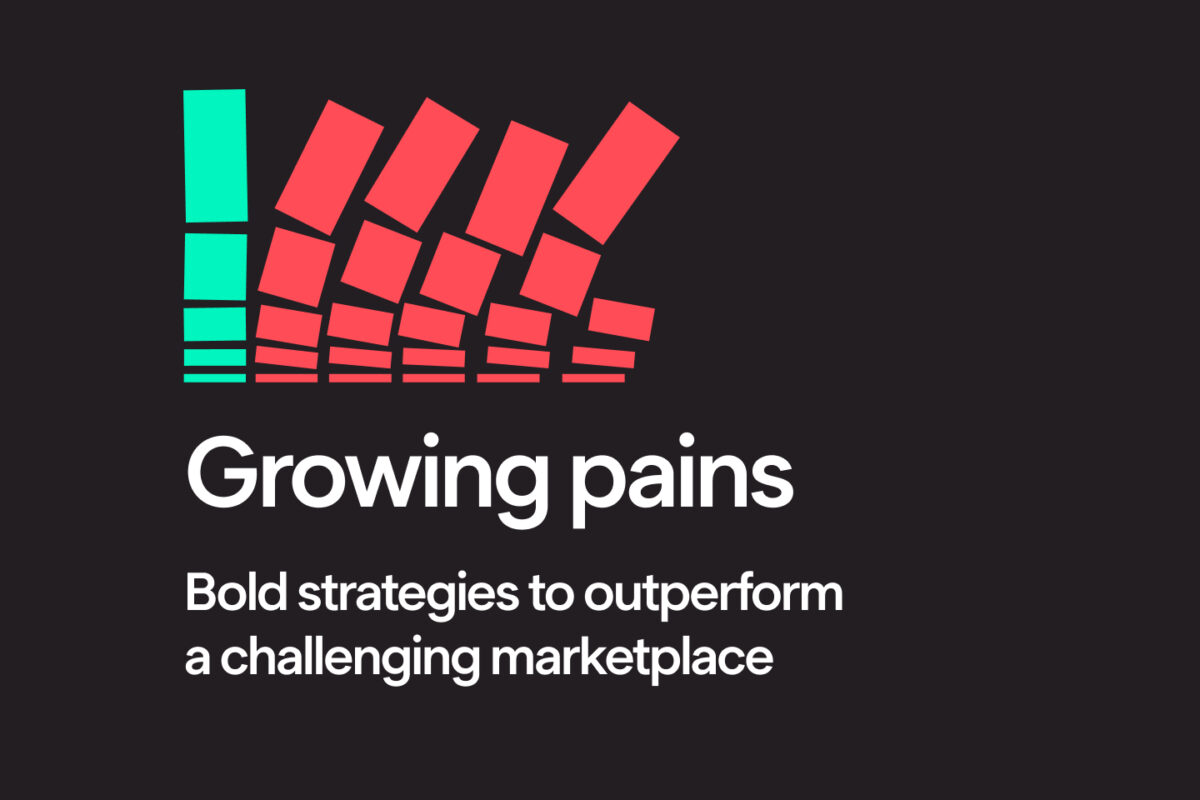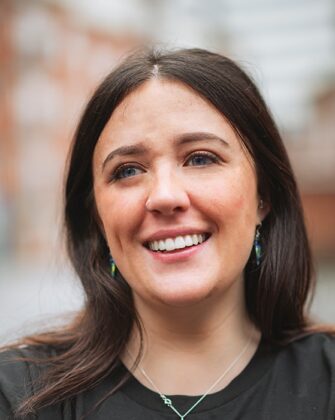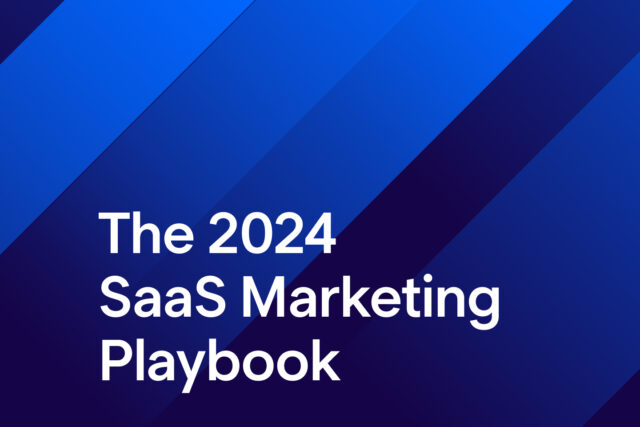On the 26th March 2024, Hallam, alongside our partners at LinkedIn, hosted an exclusive event focused on how B2B brands can achieve growth despite a turbulent socio-economic climate.
We’ve rounded up the key takeaways from the day’s talks, featuring experts from our team, LinkedIn and in-house B2B tech marketers.
Buckle in — there’s a lot to cover. Want the slides from all the talks? Download the event slides here.
Talk #1: Ben Wood, Doing more with less: How to drive profitable B2B growth
Hallam’s Performance Director, Ben Wood, offered the economic context that marketers are currently facing.
Whilst there’s no recession(correct at time of print…), 2024 continues to see slow economic growth and marketing teams are being asked to do more with less, making efficiency crucial for B2B. Factor in the impending death of third-party cookies, Apple and the IDFA evolution and increased privacy laws and you have the perfect storm.
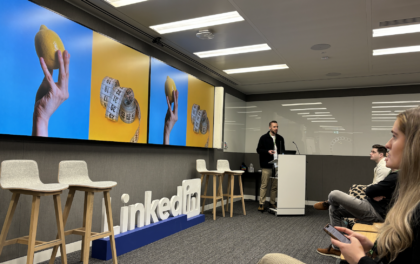
Although intimidating, this is still an exciting time for marketers. The way we search is changing, meaning brands have to shift their focus from short term gains to long term growth. Now is the time for B2B organisations to create memorable and emotive connotations in order to be at the top of consumer’s minds when the economy picks up and they are at the point of need.
Here are Ben’s top tips on how you can set you brand up for growth during this period of economic transition:
Transition to privacy-first measurement
Changes in cookies and data privacy laws is changing how marketers are attributing their digital activity.
Over the next few years, more marketers are expected to invest in MMM and experiments to triangulate the data provided via digital attribution platforms such as GA4, to more accurately assess marketing effectiveness.
Optimise for pipeline impact
Some conversions are worth more to your business and it’s important that your activity is optimised towards these to maximise efficiency.
OCT (offline conversion tracking), SSO (single stage optimisation) and VBB (value based bidding) are enable you to maximise the total value of conversions generated by your campaigns.
Be less boring!
Having a better product is not enough to win. The first rule of advertising is to “be noticed”; too often this is forgotten in B2B.
Brands who capture attention, and those who are memorable and meaningful will get ahead, and stay ahead through the long buying process.
Don’t overlook creative best practice
52% of digital budgets are wasted on creative that isn’t high quality.
Don’t ignore the passive majority:
- Integrate your search data
- Improve E-E-A-T via thought leadership
- Make it easy to buy!
Talk #2: Jennifer Shaw-Sweet, How B2B brands grow
LinkedIn’s B2B Institute EMEA Lead, Jennifer Shaw-Sweet, further delved into exactly how businesses can create these memorable moments.
Context of your marketing is incredibly important for customer recall
In the world of branding, the challenge is multifaceted; not only do brands need to capture customer’s attention, but they also need to be remembered in the right context.
Our brains function in contextual frameworks, recalling things more effectively when associated with memorable situations so, in the realm of B2B advertising, achieving mental availability becomes paramount.
Understanding where your brand stands in buyers’ minds is crucial: customer research can help with this
Particularly in times of uncertainty, such as election years and continued economic uncertainty, buyers teeter on the edge of investment decisions, gravitating towards established brands for reassurance.
To navigate this landscape, understanding where your brand stands in buyers’ minds is crucial. Surveys and audience research can shed light on this, but timing is key and catching buyers when they’re receptive is essential with the goal being to embed your brand firmly in their mental landscape.
Your brand positioning is vital in B2B. It’s not just about loyalty; it’s about market penetration and perception. Ultimately, to compete in this arena, companies of all sizes must adopt the mindset and strategies of a big brand, understanding that brand recall and market penetration drive success.
Jennifer Shaw-Sweet is LinkedIn’s B2B Institute Lead. You can find her on LinkedIn here.
Talk #3: Panel discussion between Julio Taylor (CEO, Hallam), Friné Oudeman (Head of Marketing, Luware) and Kier Humphreys (Sales Director, Hallam)
Having digested the information from the first two talks, it was time for our expert panel to take the floor and discuss their own experience and challenges as marketing professionals.
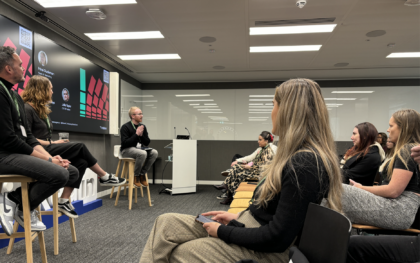
If you’re not in a price war, you’re in a brand war
Friné Oudeman, Head of Marketing at Luware, built on a point made by Ben in his opening talk; the pressure cooker of urgency from the C-suite weighs heavily on marketers, demanding investments only in proven strategies.
Hallam’s CEO, Julio Taylor, echoed this, commenting that in this race for visibility, the coveted “day one list” is a priority for B2B brands. While big-budget spots may be out of reach, there’s an opportunity for disruption through high-quality creatives over lavish spending.
Educate your C-Suite for better KPI alignment
There was a consensus amongst the panel that there is a pervasive misunderstanding of marketing across the board, highlighting the imperative for ongoing education.
Friné explained that, as digital marketing evolves into the new norm, staying on top of this ever-evolving landscape and educating key decision makers is a finely timed art.
Identify your brand’s ‘golden thread’ for creative consistency
Yet, patience remains a virtue, with all three of our experts recognising that reshaping consumer mindsets is a marathon, not a sprint.
As discussed by Kier and Julio, if you are unable to match the big brands on price, then you need to beat them on brand. Finding the “golden thread” that unites human ingenuity with technological prowess, akin to Apple’s approach, becomes paramount.
AI cannot replicate the human touch
A particular question from the audience was how to manage colleagues being overly reliant on AI or content generation.
For Julio, whilst AI promises seamless integration, its limitations underscore the irreplaceable role of human creativity. Bridging the gap between AI’s capabilities and human intuition is imperative, especially in shaping the perspectives of younger generations, who may prioritise method over outcome.
Talk #4: David Walsh, Winning customer love with account base experiences (ABX)
LinkedIn’s Head of Customer Insights, David Walsh’s talk centred on ABX: a strategy that utilises relevant, trusted marketing and sales activity throughout the B2B client journey.
Sales and Marketing alignment is crucial for B2B growth
This relies on the successful alignment of the sales and marketing teams. With a substantial 75% overlap of the leads these two departments are targeting, warming up leads through marketing initiatives significantly bolsters sales effectiveness. Surprisingly, a mere 14% of tech sales leads are directly influenced by marketing, underscoring the necessity for a refined alignment matrix. Delving deeper, exploring category entry points in research unveils insights crucial for tailoring communication with prospects.
Amidst this landscape, the re-opening of LinkedIn’s Audiences Manager beta testing presents a ripe opportunity for honing targeted outreach strategies, allowing you to combine targeting criteria to build your ideal persona. You can find out more about this here or by reaching out to your LinkedIn rep.
Chief Revenue Officers signal a shift in organisational dynamics
In navigating the complex web of attribution across departments, the emergence of Chief Revenue Officers as prominent figures signals a shift in organisational dynamics with one person taking responsibility for these factors.
There is also an argument for recognising CRM as the third department in the sales and marketing triangle, with David underscoring the importance of its setup rather than its mere integration.
David Walsh is LinkedIn’s Head of Customer Insights. You can find him here.
Talk #5: Julie Reid and Alex Jackson, The power of creative
The final talk of the day came courtesy of Hallam’s Head of Brand, Julie Reid, and Paid Media Lead, Alex Jackson, discussing the importance of impactful creatives.
The B2B buying journey is complex
Julie opened with reference to the famous 1958 McGraw-Hill print B2B advert as an example of what powerful creatives should aim to achieve:
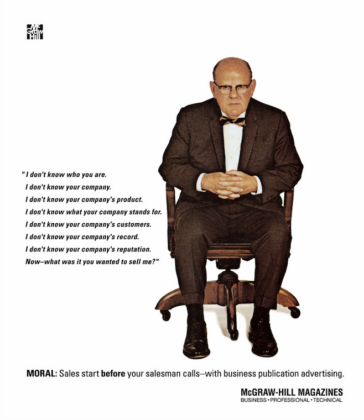
The B2B buying journey is not linear (if it ever was). Buyers roughly move through stages of problem identification, solution exploration, requirement building and supplier selection, but there are multiple external factors influencing the process. This is a major challenge – and opportunity – for marketers. They need to make their company stand out. After all, the first rule of advertising is “be noticed”.
Creatives are the single biggest determinant that is within your control
This is where creatives come in. Les Binet and Peter Field’s groundbreaking research The Long and Short of It show that creative advertising works over a longer period of time, with compounding effects on business. In fact, in Paul Dyson’s 2014 study, he found that, after brand and market size, creativity was the single biggest determinant of advertising profitability.
Creative advertising is about communicating something new and valuable to the marketplace. We start with research to uncover a series of truths that will serve as our framework, including company research, customer research and category research.
This helps map the landscape and uncover insights to create a unique, attention-grabbing position in the market.
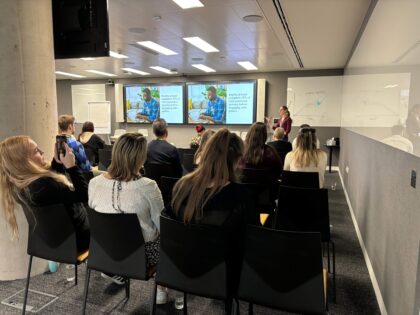
Don’t let creative assumptions be your downfall
So, once we understand who we’re going to target and then with what, we can then plan how we’re going to reach them. At this point, Alex joined the stage to discuss how media planning can maximise creative impact. Traversing the ad platform landscape can be chaos, which is why it’s so important to know the nuances and diversity of your ad platforms before you start.
There’s no one size fits all approach to marketing anymore, and every platform has its own strengths, different target audiences and ways to get in front of them. Users may be on the same platform, but spending their time in different ways, so you need to know who your audiences are, and what they do on those platforms. This all needs planning out clearly in a media strategy, so get it onto paper.
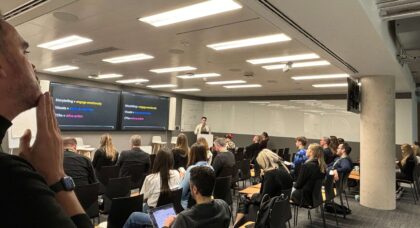
However, it’s important to remember that your initial media plan is a guide, so it’s important to be flexible and open to testing. Almost every platform has A/B testing software, and Google RSA and performance planner gives you an oversight on how ad variations and campaign optimisations can impact top level results.
Julie and Alex recommendations to B2B marketers included:
- Creativity is the amplifying effect that can help you stand out from the crowd
- Cultivate the courage to try something new
- Link your brand to buying cues and incorporate Orlando Wood’s factors to make your ads memorable
- Don’t jump in at the deep end, prepare your media strategy and map your audiences
- Creatives are more than just images – it’s everything your audience sees
- Personalise your content where you can, and remember to test, test, test!
Download the megadeck slides
Can we help you?
Having a clear understanding of B2B buying behaviours and needs is the catalyst for more effective decision making.
Find out what good really looks like — set us a challenge that will change your year. Reach out to our team.
